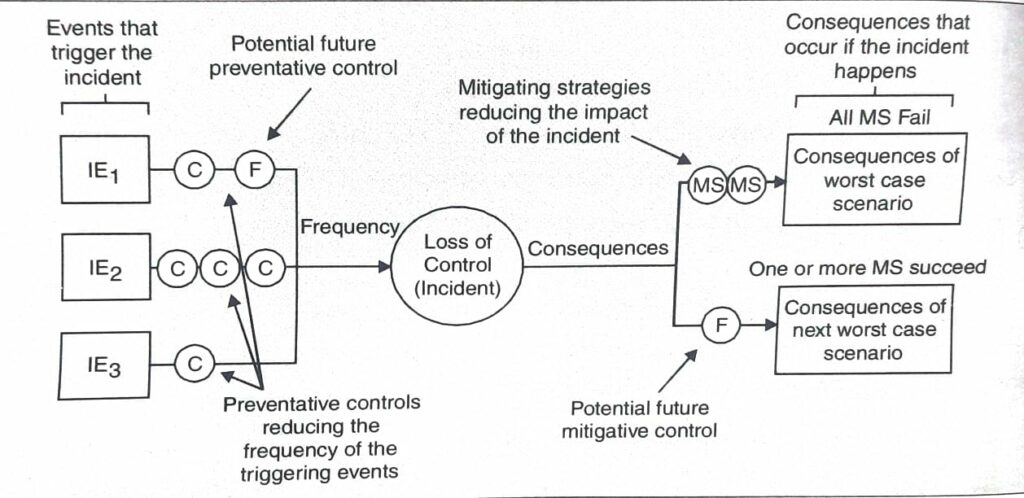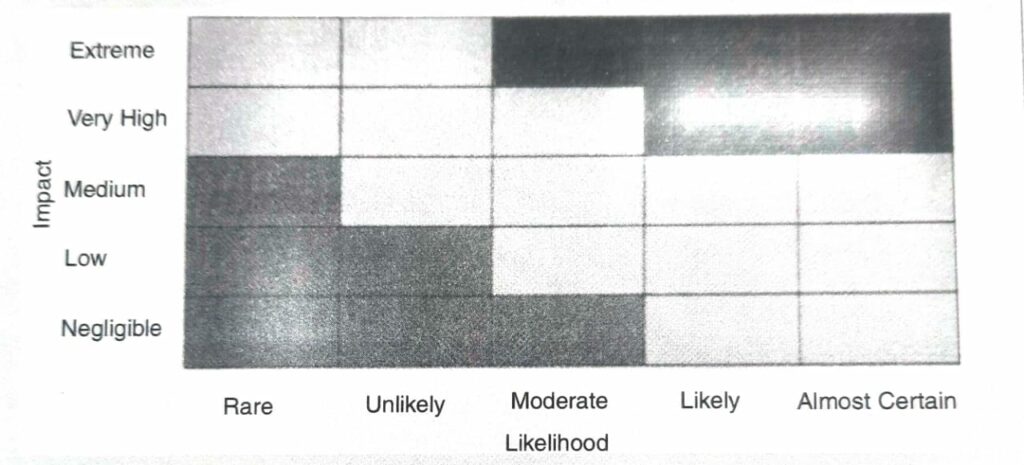RISK EVALUATION
Risk evaluation is the process of measuring and prioritizing risks so that optimum risk-return relationships can be established. This can help in controlling the risk levels of the organisation.
RISK ASSESSMENT PROCESS / RISK EVALUATION PROCESS
Risk evaluation process or risk assessment involves the following steps:

RISK IDENTIFICATION
The first step in risk assessment is Risk identification. It is necessary to identify the risk involved in a particular project or business. It is must to manage the risk. If the risk managers are not able to identify the risk, then it is impossible to manage the risk. Thus, it is must for every risk manager to identify all kinds of risks (financial, operational, strategic etc.) and sub categories of risk like market, credit, liquidity etc. The risk managers have to identify key risk involved in a particular project.
RISK ASSESSMENT
The next step in risk evaluation process is to assess the quantity of risk by checking the likelihood and severity of impact of risk in a particular project or business. The likelihood of risk event determines the probability of occurrence of an event. The risk manager will have to identify the risk with highest probability and its impact on business.
The risk assessment process further involves four steps:

(a) Develop Criteria
The first step in Risk assessment process is to develop the criteria or base on which the risk is assessed or prioritised of a particular firm or project. The criteria set a benchmark on basis of which the comparison on company basis, industry basis is done.
(b) Assess Risk:
After developing criteria, risk is assessed with the help of various qualitative and quantitative techniques discussed below in detail:
QUALITATIVE TECHNIQUES OF RISK ASSESSMENT OR RISK EVALUATION
Qualitative techniques are those techniques which cannot be measured in monetary value. These techniques are subjective in nature and evaluate the risk by comparing the situations and ranking the situation in ordinal scale like high- moderate-low, vital-critical etc. Thus, qualitative techniques can study the impact or magnitude of risk.
Some of the commonly used Qualitative techniques are interviews, cross-functional workshops, surveys, benchmarking, and scenario analysis.

Interviews and Cross Functional Workshops
It is one of the most important and common qualitative technique to assess the risk involved in any project or business. The one-on-one interview can facilitate solution to their problem. In the same way, the cross-functional workshop helps in building a cross functional team from different departments in order to solve the problem. This method is better than the interview method as in this case every member of the team represents different departments such as engineering, production, finance, marketing etc. This helps in considering the perspectives of all the departments. They can review internal and external data with the help of expert judgement to assess the probability and severity of the risk
Interviews are more suitable at the top level of management for taking important decisions on right time whereas Workshops may not be suitable where there is centralisation of powers in few hands.
Surveys
One of the techniques of qualitative analysis is surveys. This method is applied where the population is large and it is difficult to collect information from each and every individual. Surveys are generally done with the help of questionnaires filled by few individuals. These questionnaires are then analysed with the help of statistical tool to get accurate results but this method is also not away from its limitations. The questionnaire method suffers from various limitations such as low response rate, incorrect information or poor quality of information and one of the major limitations is that it is confined to literate people only.
Benchmarking
Benchmarking is a technique where a firm can compare itself to the best in the industry. They can compare various practices or processes with the best practices followed in the industry. In this they can compare themselves and identify the opportunities of improvement for the firm. Some firms can compare themselves across the industries and study the impact of an event across industry. Benchmarking can also be used to assess the probability and severity of potential events across an industry. Benchmarking data are also available from various research agencies, government surveys and regulatory bodies.
Scenario Analysis
Scenario analysis gives an analysis of future possible events. It does not show one exact event but analyses the entire scenario and give different alternatives. The number of alternatives is limited to three as more alternatives can create confusion rather than giving a solution to a problem.
Causal At-Risk Models
When all the above discussed models/analysis fails to give accurate results, the causal at-risk models help the risk managers to take right decision at right time. It is one of the most sophisticated techniques of risk assessment especially in financial sector. These probabilistic models can help in identifying key drivers (factors) to risk.
Gross Margin at Risk (GMaR), Cash Flow at Risk (CFaR), and Earnings at Risk (EaR) are some of the metrics based on specific risk factors affecting the earnings of the firm. It is based on the logic that earnings or cash flows are true indicators of performance and impact of risk factor would ultimately lead to change in the cash flows or earnings of the firm. Thus, each risk factor must be incorporated into the overall model.
This model is based on past or historical data and where such information is not available, expert views may be used to predict the probabilities and severity of the risk factor. But experts can also get biased and may not give true and exact information.
Advantages of Qualitative techniques of Risk assessment or evaluation:
- It is easy to understand.
- It leads to quick decision.
- It provides experts view on the impact and probability of risk event. It can give an insight of the situation on the basis of past experiences.
- It considers both financial as well as non-financial impact.
- It is easy to understand as technical knowledge is not required.
Disadvantages of Qualitative techniques of risk assessment or risk evaluation:
- It is based on ordinal scale such as high, low, medium, very high etc.
- It is not precise as it gives range of information and not exact level of risk.
- It is subjective in nature and cannot give numerical data.
- Cost-benefit analysis is also not possible under this method.
QUANTITATIVE TECHNIQUES OF RISK ASSESSMENT OR RISK EVALUATION
Quantitative techniques of risk evaluation are those techniques which give result in numerical value and are more objective in nature. It measures the risk on cardinal scale and gives result in definite value.
There are many tools and techniques available to perform quantitative risk analysis. Below are a few of them:

- Decision Tree Analysis: A visual technique that supports decision-making.
- Expected Monetary Value: A statistical technique that helps to compare and evaluate risks. It can be used along with decision tree analysis.
- Three-Point Estimate: Three-point estimate is applicable to both duration and cost estimates. It relies on three different estimates that are Optimistic, Pessimistic, and Most Likely estimates.
- Sensitivity Analysis: Sensitivity analysis is also referred to as what-if or simulation analysis. It is a financial model that identifies how target variables are affected based on changes in other variables.
- Failure Mode and Effects Analysis (FMEA): is the process of analyzing as many components as possible to determine potential failure modes in a system and their causes and effects.
- Monte Carlo Analysis: Monte Carlo Analysis is performed to model the probability of various outcomes in a process that can’t handily be estimated because of the intervention of random variables. It is used along with three-point estimates.
Advantages of quantitative techniques of risk evaluation or risk assessment
- It is objective in nature.
- It gives numerical data in support of their conclusions, It identifies the risk involved in cash flows and earnings of a particular firm by measuring “at risk” such as Cash Flow at Risk.
- It is suitable in cost-benefit analysis.
- An optimal risk-return relationship can be established.
- It also helps in maintaining solvency under critical conditions.
Disadvantages of quantitative techniques of risk evaluation or risk assessment
- It is complex and technical knowledge is must.
- It is time-consuming and costly.
- In this expert opinions are ignored and thus qualitative aspects are missing.
- It is not easy to understand by the employees.
(c) Risk Interactions
The third step within risk assessment is to determine risk interactions. Risk do not interact in isolation but its effects get magnified when it gets interacted with the environment in which the business survives. Thus, it is very essential to study and assess risk interactions. There are various techniques like bow-tie diagrams, risk interaction matrices, fault trees and event trees etc.
Fault tree analysis (FTA) was originally developed in 1962 at Bell laboratories. The method is generally used to analyse the system of failure in order to avoid or minimise the risk by taking precautions on the basis of this fault tree. This tree can give sequence of events that may occur in the event of any kind of failure. On the basis of this sequence steps are taken to minimise the risk at different levels. It is generally used high hazard projects aerospace, nuclear power etc. It uses various graphical symbols to make tree of failures in which main failure is broken into other failure events.
Bow-Tie Diagrams
Bow-tie diagrams are graphical representation of events which helps in displaying the cause, preventive measures of major accidents in such a way that it is easy to communicate to all the employees in easy and effective manner. The bow-tie diagram gets their name from the graphical image they form. They are very effective risk assessment tool. They can act as a tool of quantitative analysis and thus helps in assessing the risk the help of other methods also. The general structure of a bow-tie diagram is represented in the diagram below.

(d) Prioritise Risk
The fourth and the last step is to prioritise the risk assessed or evaluated. These rankings are essential to manage the risk. The risk manager can pay more attention to those risks which are significant in the nature. The prioritisation of the risk is done in two steps:
- They are ranked according to one or more criteria like its impact, likelihood or vulnerabilities etc.
- Then these ranks are revised in the light of other factors.
On the basis of this, a hierarchy is formed which has to be managed in a proper or systematic manner. These risks are then plotted on the risk map or heat map which further clarifies the situation. The risk map can give detailed analysis of likelihood and impact of risk event on an ordinal scale of high, low medium etc.

RESPOND TO RISKS
The last step in the risk assessment process or risk evaluation process is to minimise the risk by responding to the risks evaluated in a very rational manner. Various response options such as accept, reject or avoid are examined in the light of the above analysis and the cost benefit analysis is done to reach at the conclusion.
